ASUS PA246Q 24" ProArt Monitor: No Adjustments Needed?
by Chris Heinonen on July 2, 2012 1:30 PM ESTASUS PA246Q - Display Uniformity
The large viewing angles allowed by an IPS panel only truly help if colors are accurate at the edges of the screen and not just in the center. On the PA246Q the lower-left of the panel seems to be brighter than the rest of it, as it is close to the same level as the center of the screen but the right and top sides of the panel are a bit dimmer. Even with those sides being dimmer, that is better than most displays where all sides are dimmer instead of just 50% of them. So white uniformity is better than average, but not perfect.
Black uniformity shows the same pattern, only in this case as the lower-left is brighter, it has worse performance that the upper right. If these black levels look worse than the previous black levels we discussed, these are set with the backlight at the level needed for 200 nits of white, which was around 40 brightness on this display.
Because I have the data, I added another chart this time, Contrast Uniformity. This simply takes the previous two charts and shows the relative contrast across the screen. Surprisingly the worst contrast was in the dead center of the display, so perhaps if I were to go back and do this chart for other displays I would find the contrast number we use is a worst-case-scenario. In any case, I plan to use this going forward as well since we already have the data, and we can see how close the contrast ratio is across the screen. Here the standard deviation is only 4.26%, which is lower than both the white and black uniformity deviations. So if you are dimmer in white, you’ll be darker in black by a comparable degree it seems.
Finally we can look at the dE uniformity of the PA246Q. Broken down by color the dE values are close for the most part, though the lower-left section of the screen is clearly way off on the grayscale and in most other colors relative to the rest of the screen. Surprisingly the center-bottom of the screen outperforms the center, which is what we calibrate to as our target, which is a bit strange. The average deviation for each sample is almost half a dE, which is a pretty large deviation when you consider that the average dE is right around 2. Overall the PA246Q seems mostly uniform, but with a couple outliers here that tend to skew the data.
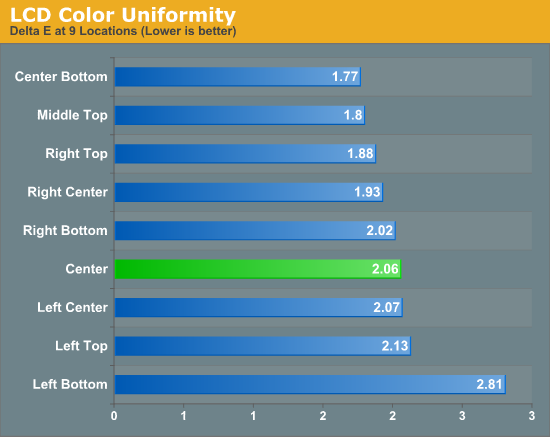


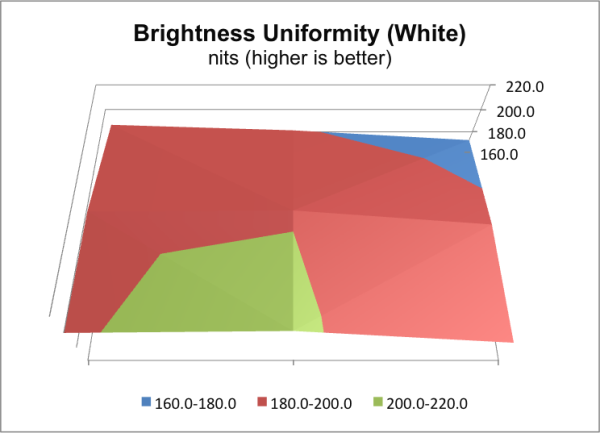
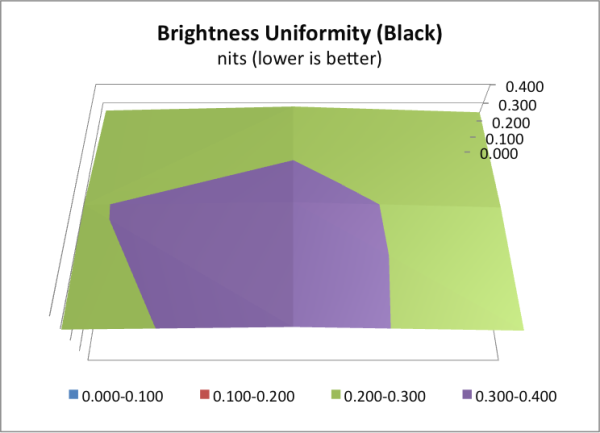
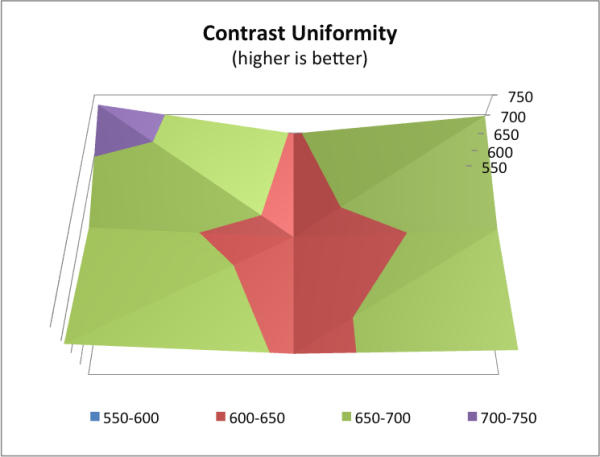
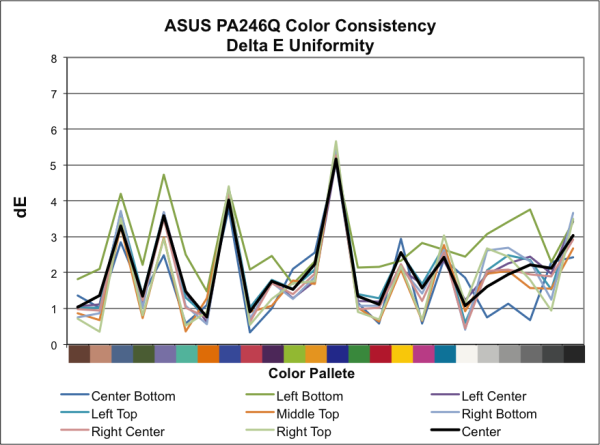
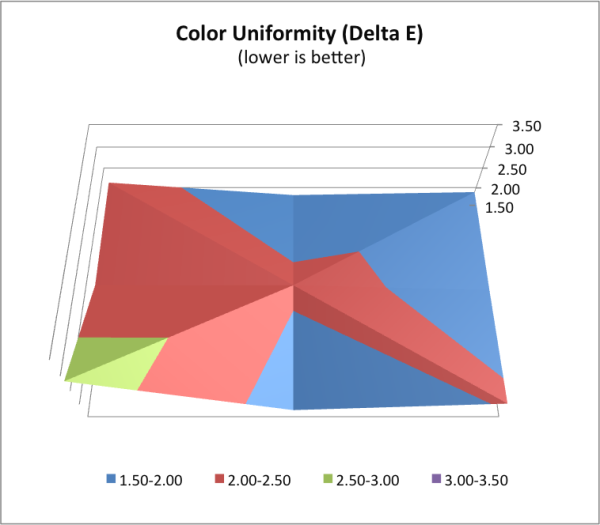








52 Comments
View All Comments
synaesthetic - Tuesday, July 3, 2012 - link
I'd pay a lot for a 1920x1440 24" monitor!aranyagag - Tuesday, December 11, 2012 - link
i just wish such a display was availablearanyagag - Tuesday, December 11, 2012 - link
+1 for 16:10 --voted with my walletCorporate Goon - Monday, July 2, 2012 - link
Just wanted to leave my two cents as I've owned this monitor for about six months now.I've generally been very impressed with this monitor - I have a wide variety of needs and I find it fits most of them. I do some semi-pro video and photography work but nothing too fancy (photoshoots for local bands, that sort of thing), play lots of games and do some Netflix watching and the like. I've been very pleased generally with the Asus display - the colours are great, and a huge step up over my TFT display I had before. I've also noticed no ghosting issues at all in games and movies (I initially replaced my 'old' 24" TFT with a BenQ MVA panel and while the contrast was incredible, the streaking and ghosting was a major distraction).
My only major complaint about the display is the poor black levels relative to newer LED-backlit screens. Compared to my old TFT/CCFL display the Asus is about on par, but it can't hold a candle to the newer TFT/LED and MVA/LED screens.
I've recommended the screen to a couple of friends who are in similar boats to me - people who use their computer for entertainment, but are also reasonably serious about using it for art/video/photography.
Leyawiin - Monday, July 2, 2012 - link
"there is no game mode or overdrive for enabling faster response from the display"ASUS's term for Overdrive is Trace Free. Its permanently active in this model (can't turn it off or change the degree).
aranyagag - Tuesday, December 11, 2012 - link
A very astute observation -- thanks for posting this insightdishayu - Tuesday, July 3, 2012 - link
There are so many cheap 27 inch korean IPS 2560x1440 resolution displays on ebay that sell for under $400. They utilize panels from LG, the same ones used in Apple's cinema display. I would REALLY like to see a legitimate review of them. I'm quite inclined to buy them but i don't want to end up wasting 500 of my bucks. If only Anand could review them somehow?Here's an ebay link. (this is the pixel perfect model, which comes with a guarantee of zero defective pixels)
http://www.ebay.com/itm/CROSSOVER-27Q-LED-Perfect-...
rsgeiger - Tuesday, July 3, 2012 - link
Basically the only way Anand can review it is if you bought it and sent it to them. They only review what companies send to them for review. They dont buy their own gear.prophet001 - Tuesday, July 3, 2012 - link
It would be nice to see a review of something like that. However, I think it's safe to say that it's not that cheap because it has the same quality as other similarly spec'd panels.dishayu - Tuesday, July 3, 2012 - link
Doesn't apple's 27 inch IPS cinema display cost something in vicinity of 1000 dollars?I just randomly linked this one as it was the first to turn up in my search results. There are monitors selling for around 360 mark as well. And 299 if you don't want a 0 defective pixel warranty (replacement only for 5 bad pixels or more, a couple of pixels out of 3.7 million might not even be noticable at this pixel density but i don't know that for sure)